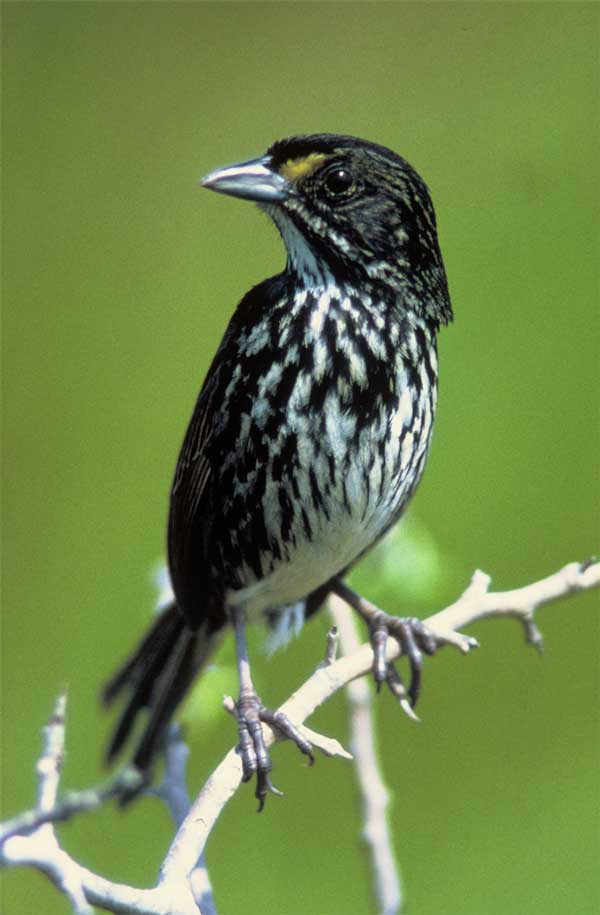
Ammospiza maritima (United States Fish and Wildlife Service)
Superregnum: Eukaryota
Cladus: Unikonta
Cladus: Opisthokonta
Cladus: Holozoa
Regnum: Animalia
Subregnum: Eumetazoa
Cladus: Bilateria
Cladus: Nephrozoa
Superphylum: Deuterostomia
Phylum: Chordata
Subphylum: Vertebrata
Infraphylum: Gnathostomata
Megaclassis: Osteichthyes
Cladus: Sarcopterygii
Cladus: Rhipidistia
Cladus: Tetrapodomorpha
Cladus: Eotetrapodiformes
Cladus: Elpistostegalia
Superclassis: Tetrapoda
Cladus: Reptiliomorpha
Cladus: Amniota
Classis: Reptilia
Cladus: Eureptilia
Cladus: Romeriida
Subclassis: Diapsida
Cladus: Sauria
Infraclassis: Archosauromorpha
Cladus: Crurotarsi
Divisio: Archosauria
Cladus: Avemetatarsalia
Cladus: Ornithodira
Subtaxon: Dinosauromorpha
Cladus: Dinosauriformes
Cladus: Dracohors
Cladus: Dinosauria
Ordo: Saurischia
Cladus: Eusaurischia
Subordo: Theropoda
Cladus: Neotheropoda
Cladus: Averostra
Cladus: Tetanurae
Cladus: Avetheropoda
Cladus: Coelurosauria
Cladus: Tyrannoraptora
Cladus: Maniraptoromorpha
Cladus: Maniraptoriformes
Cladus: Maniraptora
Cladus: Pennaraptora
Cladus: Paraves
Cladus: Eumaniraptora
Cladus: Avialae
Infraclassis: Aves
Cladus: Euavialae
Cladus: Avebrevicauda
Cladus: Pygostylia
Cladus: Ornithothoraces
Cladus: Ornithuromorpha
Cladus: Carinatae
Parvclassis: Neornithes
Cohors: Neognathae
Cladus: Neoaves
Cladus: Telluraves
Cladus: Australaves
Ordo: Passeriformes
Subordo: Passeri
Infraordo: Passerida
Superfamilia: Passeroidea
Familia: Passerellidae
Genus: Ammospiza
Species: Ammospiza maritima
Subspecies: A. m. fisheri – A. m. macgillivraii – A. m. maritima – A. m. mirabilis – A. m. nigrescens – A. m. peninsulae – A. m. sennetti
Dubious taxa or synonym: A. m. juncicola – included in peninsulae; A. m. pelonota – included in macgillivraii.
Name
Ammospiza maritima (A. Wilson, 1811)
Synonyms
Fringilla maritima (protonym)
Ammodramus maritimus (A. Wilson, 1811)
References
Primary references
Wilson, A. 1811. American ornithology, or, The natural history of the birds of the United States: illustrated with plates engraved and colored from original drawings taken from nature. 4: v–xii, 13–100, pl.28–36 Philadelphia. Bradford & Inskeep. DOI: 10.5962/bhl.title.97204 BHL Reference page. p. 68 BHL pl. 34 fig. 2 BHL
Additional references
Klicka, J., Barker, F.K., Burns, K.J., Lanyon, S.M., Lovette, I.J. & Chaves, J.A. 2014. A comprehensive multilocus assessment of sparrow (Aves: Passerellidae) relationships. Molecular Phylogenetics and Evolution 77: 177-182. DOI: 10.1016/j.ympev.2014.04.025Reference page.
Vernacular names
čeština: Strnadec pobřežní
dansk: Kystspurv
Deutsch: Strandammer
English: Seaside Sparrow
español: Chingolo Costero
eesti: Randsidrik
suomi: Sarasirkkunen
français: Bruant maritime
magyar: Tengerparti verébsármány
italiano: Passero delle coste
日本語: ハマヒメドリ, hamahimedori
Nederlands: Kweldergors
norsk: Marskspurv
polski: Bagiennik żółtoczelny
русский: Приморская овсянка
slovenčina: Strnádlik prímorský
svenska: Kustsparv
中文: 海滨沙鹀
The seaside sparrow (Ammospiza maritima) is an American sparrow.
Adults have brownish upperparts with gray on the crown and nape, and a grayish-buff-colored breast with dark streaks; they have a dark face with gray cheeks, a white throat, and a short, pointed tail. Birds show a small yellow streak just above the eye.
Their breeding habitat is salt marshes on the Atlantic and Gulf coasts of the United States from southern New Hampshire to southern Texas. The nest is an open cup usually built in the salt marsh on tidal reeds and spartina grasses. Females lay two to five eggs.
Northern birds most often migrate farther south along the eastern coast of the United States. They forage on the ground or in marsh vegetation, sometimes probing in mud. They mainly eat insects, marine invertebrates and seeds. Their feeding areas are often some distance away from the areas they choose to nest.
The recently-extinct dusky seaside sparrow (A. m. nigrescens)
One of the numerous subspecies of this bird, the dusky seaside sparrow (A. m. nigrescens), has recently become extinct, and the Cape Sable subspecies, A. m. mirabilis, is endangered. Occurring in a restricted range but of uncertain validity is Scott's seaside sparrow, (A. m. peninsulae). Those were formerly considered a separate species.
The song is a raspy buzz that closely resembles a distant red-winged blackbird.
References
BirdLife International (2018). "Ammospiza maritima". IUCN Red List of Threatened Species. 2018: e.T22721123A132007297. doi:10.2305/IUCN.UK.2018-2.RLTS.T22721123A132007297.en. Retrieved 12 November 2021.
Retrieved from "http://en.wikipedia.org/"
All text is available under the terms of the GNU Free Documentation License

